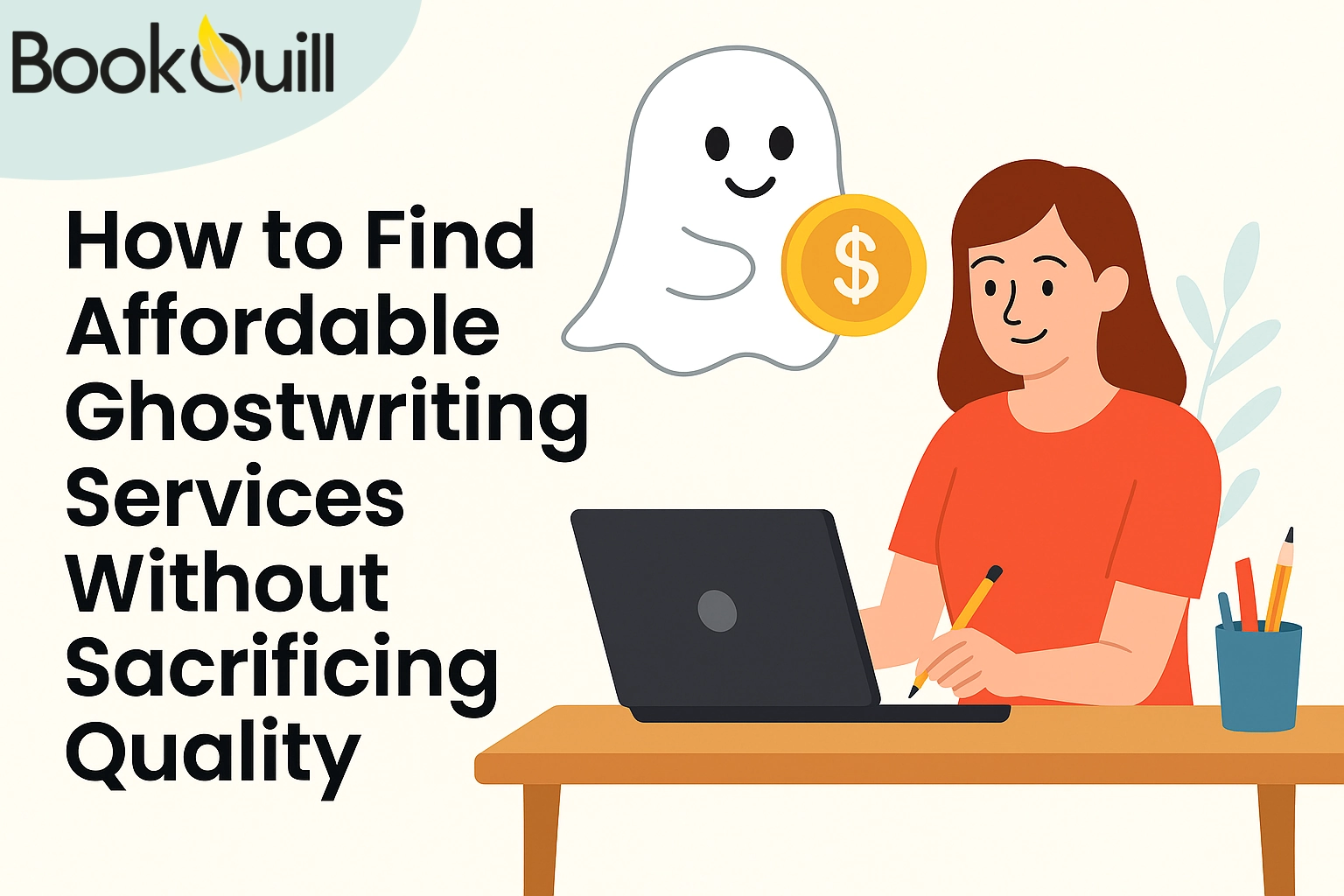Table of Contents
Explore Blogs
Trending on Ebook
How to Make Your Book into an Audiobook

You probably notice more people listening to audiobooks while they jog or run errands than ever before. This is because audiobooks have gained massive popularity in the past few years.
In fact, the Audio Publishers Association’s annual sales survey reports a double-digit increase in audiobook sales for the 11th consecutive year. The stats reveal that over half of the American population (a whopping 53%) have listened to an audiobook at some point.
Did You Know?
The global audiobook market is valued at approximately USD 5 billion. It is expected to be worth over USD 39.1 billion by 2032
What do these numbers mean for you as an author? It means you can tap into this massive market if you turn your book into an audiobook. If the only thing stopping you from doing so, is not knowing how to record an audiobook, we can help you!
In this post, we teach you how to turn a book into an audiobook in eight simple steps. Are you ready to convert your book into an audiobook? Let’s get started!
How to Make an Audiobook?
- Step 1. Decide on the Narration Approach
- Step 2. Find a Narrator
- Step 3. Set up the Recording Studio
- Step 4. Record Your Audiobook
- Step 5. Edit Your Audiobook
- Step 6. Choose the Cover Art
- Step 7. Publish Your Audiobook
- Step 8. Promote Your Audiobook
Step 1. Decide on the Narration Approach
So you want to learn how to record an audiobook? First thing first, you need to decide your narration approach! You’re mistaken if you think you can just walk into a recording studio and give a moving performance unprepared for the narration process. It’s not that easy!
More goes into narration than people realize. If you prepare your manuscript, you will save time, and money and be able to produce a high-quality audiobook. Here is how you can plan your narration:
-
Reading Prep

If you are narrating your book, read it till the end again. It’s important to become familiar with the content before you start recording. Read the book out loud multiple times and note any sentences or paragraphs you struggle with. Spend time practicing these sections so you don’t struggle with them while recording.
Read the manuscript out loud and practice any sections you struggle with to avoid interruptions during recording!
Narration is not just reading, it is a performance. You can make the listening experience engaging and interesting by putting in effort to perform sections that need emphasis, emotional nuance, or changes in pacing.
-
Pronunciation Practice
Look through your manuscript and pay attention to challenging words, names, or terms. These could be names of characters, chemical substances, or tricky places you’re struggling to pronounce.
Keep in mind that even professional voice-over artists stumble over difficult words. This is especially the case for non-fiction books that may include technical terms. Practice the correct pronunciation of these words to avoid hiccups during recording.
Even professional narrators are stumped by uncommon names and technical terms. Use audio dictionary apps and YouTube videos to help with pronunciation.
If there are any uncommon, highly technical, or difficult words in your book that the narrator might struggle with, create a guide for them with pronunciations of the words. Automated tools like Pozotron can help with pronunciation research. YouTube and Audio dictionary apps are also great options for researching the pronunciation of tricky words.
-
Images, Graphs, and Tables
If you have charts, graphs, or images that you reference in the book, you will have to deal with them before you start recording. Typically, books with these visual aids provide a supplemental document with the audiobook that the listeners can download. However, some distribution platforms don’t support this approach.
Hosting images, charts, and tables on your website is a good alternative to offering a PDF document. It makes for a better viewing experience and lets people interact with your content online.
Viewing documents on a small screen can be tedious. It can take away from the listening experience. It’s better to let the people know at the start of the audiobook where the images you are referencing are present. When preparing your manuscript for the recording, make sure you remove any language addressing the image or chart that doesn’t make sense like “see the image below” or “refer to table X.”
Services like Scribely can help create detailed descriptions of tables and charts so people can understand them without seeing them.
If you are concerned about accessibility and want to give the complete book experience within the audiobook, use services like Scribely. They can help create detailed descriptions of tables, images, and charts so people can understand them without seeing them.
-
Decide on Character Voices
For non-fiction books, it’s important to have a consistent tone, style, and narrator voice. However, giving characters different voices would enhance the listening experience if you have a fiction book. Plan out the character voices and make sure you take the personality and traits into account.
All this prep will help you decide on your vision for the book. It’s important to complete this preparation so that when you narrate your book or find a narrator, you know what you want the end product to look like.
Step 2. Find a Narrator
If your budget allows it, find a professional narrator. While you can record audiobooks by yourself, a professional narrator has experience with audiobook recording and can bring a lot to the table. A professional voiceover artist can:
- Create different character voices
- Switch between styles and accents
- Read out loud in an engaging way
- Pause in the right places
- Execute your book to perfection
Professional narrators have spent years perfecting their voices and polishing their audiobook narration skills. If you do not want to go through the trouble of practicing narration and learning the nuances, it is better to hire a professional who can do justice to your book.
ACX hosts a community of audiobook recording professional you can connect with. Hire the perfect narrator, sound engineer, and producer for your audiobook genre.
ACX is a popular audiobook platform that connects audiobook creators with professionals. It matches you with experienced narrators, sound engineers, and technicians for your project. You can invite narrators to audition for your book and decide the voice you like best. You need to provide narrators with an excerpt they can read and audition with.
BookQuill can also help with the narration of your audiobook. Choose a voice from our library of samples and leave the hassle of recording to the professionals. Call us now at 1-833-587-7003.
Step 3. Set up the Recording Studio
If you hire a narrator, they might already have a recording studio they work from. So before you go purchasing any audiobook recording equipment, talk to your narrator.
If you are narrating your book yourself, you can either rent a recording studio or build your own. Renting can be costly depending on how long the process lasts but setting up your studio doesn’t come cheap either.
If you have experience in narrating audiobooks, it is best to rent and record your audiobook as there is little margin for error. If you are new to recording audiobooks and plan to record more audiobooks in the future, getting your own audiobook recording equipment is a good idea.
To set up a recording studio, you need a soundproof space and the right equipment. Essential audio gear includes a good-quality microphone, headphones, pop filter, and professional recording software. You would also need a laptop with at least 8 GB RAM.
To soundproof the space, invest in acoustic treatment materials like brass traps, panels, and diffusers. For a more detailed guide on setting up your recording studio, check out this article.
Step 4. Record Your Audiobook
If you have hired a narrator, you don’t need to worry about the recording process. The narrator will record and send you the files. However, if you are recording the audiobook yourself, we recommend investing in a recording software.
Recording software like Audacity and Adobe Audition provides a digital workspace where you can record and refine audio files. With these tools, you can edit out any background noise, correct mispronunciations, and maintain a consistent audio level which is required by audiobook distribution channels.
Popular examples of recording software include Audacity and Adobe Audition. Audacity is a free, open-source software and is best for beginners. Adobe is a paid tool with more professional sound recording and editing options.
It is best to start with manageable one to two-hour recording sessions. This way you can maintain focus and vocal clarity. Again, the audio quality directly contributes to a good listening experience therefore, it is important to prioritize quality over quantity.
Take breaks and hydrate during the recording process to avoid vocal fatigue. When you’re recording, keep an eye on the audio levels. Wear headphones to listen to the audio in real time. This way if you mess up a section, you can simply redo it.
If you accidentally mispronounce words or suspect there is unclear audio in any particular section, don’t hesitate to redo a sentence or paragraph. Your narration needs to be clear and articulate, which may at times require you to redo sections.
Step 5. Edit Your Audiobook
After recording all the audio, the next step is editing. Even the most seasoned narrators make mistakes, so be prepared to spend time refining the recordings. You can use Audacity and Adobe Audition to edit the audio files as well.
The basic audio editing process includes removing background noise, correcting mispronunciations, and ensuring a consistent volume and pacing throughout the audiobook.
Every distribution platform has certain technical requirements for audiobooks. These may include specific sound levels, file length, format, etc. For example, Audible requires every chapter to have a separate file and none of the files should exceed 120 minutes.
Check out the distributor’s platform and make sure your audiobook recording complies with these requirements otherwise, the platform will not publish it. If you lack the skills to edit the audio yourself, it is best to leave the editing to a professional audio engineer. You can hire professional audio engineers through ACX.com.
Step 6. Choose the Cover Art
While the cover art is typically associated with printed books, it plays an important role in marketing your audiobook as well. The cover art should be visually appealing. It should be interesting enough so people want to click on it and see what it’s about. The cover of your audiobook should be connected to the main theme of your story.
Hire a graphic designer who understands your vision for the cover and can help you create a compelling audiobook. The key is to create a cover that aligns with your book’s branding.
Step 7. Publish Your Audiobook
With your audiobook recorded, edited, and cover art finalized, it’s time to publish. Platforms like ACX, Audible, and Findaway Voices are all great options. The difference is in the loyalty structures these platforms offer. Choose a distributor that aligns with your goals
Once you select a platform, make sure you follow the platform’s submission guidelines carefully. Your audio files should meet their technical specifications. Learn more about different audiobook distributors here.
Audible vs Findaway Voices
Audible offers 40% royalties on an exclusive contract and 25% royalties on a non-exclusive contract. In an exclusive deal, your audiobook will only be published on Audible, Amazon, and iTunes. Findaway Voices offers 80% royalties to authors. Your audiobooks are published on a wider range of platforms including, Spotify, Audible, Apple Books, Google, Chirp, and Scribd.
Step 8. Promote Your Audiobook
Published your audiobook? You’re not quite done yet! The next step is to effectively promote your new creation. If you have an existing author platform, leverage it to announce the audiobook release. Post about the release date and what the audience can expect from it on your website, social media, and newsletters.
Encourage your audience to leave reviews and ratings to boost visibility on platforms like Audible. You can collaborate with audiobook bloggers, podcasts, and other influencers to expand your audiobook’s reach.
Keep in mind that marketing is an ongoing process so keep engaging with your audience and continue promoting your audiobook every chance you get.
Why Turn Your Book into an Audiobook?
The numbers indicate that audiobook sales have increased considerably over the years and the industry is expected to grow more in the upcoming years. There are many benefits of turning written work into an audiobook for authors:
-
Revenue
Audiobooks are another way to make money as authors. Through platforms like Audible and iTunes, you can monetize your audiobook sales, and get a continuous source of income other than traditional book sales. The money you make from audiobooks depends upon the royalty structure you agree with your distributor.
If you sign a non-exclusive distribution deal with ACX.com, you get a 25% royalty share. In an exclusive distribution deal, authors get a 40% royalty share.
-
Exposure
Making your book into an audiobook can help build your brand. With audiobooks comes media exposure like podcasts, TV appearances, and interviews, bringing attention to your work. This way you can connect with potential clients, authors, and investors.
It shows your commitment to your work and willingness to adapt it to different formats to meet the evolving preferences of the global audience.
-
Accessibility and Convenience
Audiobooks are convenient and allow people with busy schedules to enjoy literature. Whether it’s multitasking at home, commuting, or exercising, listeners can listen to your book effortlessly. They have made content more accessible and met the needs of a fast-paced lifestyle.
Another great thing about audiobooks is that they are digital products, just like eBooks hence they are always available to purchase. Potential listeners can instantly download your book day or night.
Final Word
Turning your book into an audiobook opens up new ways for reaching readers who prefer to listen rather than read. By carefully completing each step of the audiobook creation process, you can bring your story to life in a new and more accessible format.
The numbers suggest that the audiobook platform is growing. As an author, it offers another avenue to showcase your work. We suggest you embrace the audiobook revolution and connect with your readers that is waiting to experience your words in a whole new way.
Frequently Asked Questions
How much does it cost to turn book into an audiobook?
Audiobook recording cost depends on various factors including book length, narrator’s fee, production quality, and royalty share. On average, producing an audiobook cost from between $1500 to $6000.
How to turn my book into an audiobook?
To create your own audiobook, prepare for narration or hire a narrator, set up a quiet recording space if you’re recording it yourself, record, edit out mistakes and noise, master the audio, export in MP3 or WAV format, and distribute it on platforms like Audible or SoundCloud. Promote your audiobook for visibility.
Is selling audiobooks profitable?
Your earning from audiobooks depends on the audiobook sale and your royalty share. The royalty share you get depends on your contract and distribution platform. Typically, royalty rates range from 25% to 40%.




